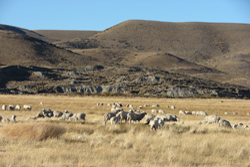She told us: “I think you are correct in that the supply chain for animal fibres does not readily fit into the framework suited to oil and plant-based fibres. The first stage of each supply chain is the production of the fibre ‘raw materials’. Considering fibre from ruminant animals, the first farm stage is unique in two respects – there are multiple high value products (meat, wool and milk from sheep), and animal production is the dominant contribution to environmental impact categories such as GHG emissions.
She adds: “In the remainder of the wool value chain, the stages that take greasy wool through processing, manufacture and distribution, use and recycling/disposal, are not greatly different to those for other textiles (notwithstanding the unique characteristics of wool that give benefits in use and recycling). For these stages the co-product considerations are not dissimilar to those for other textiles, e.g. scouring giving clean wool and lanolin, is comparable to ginning gives cotton fibre and cotton seed. In each case, both products have value but there is a clear major product. Economic allocation has been shown to be able to be conveniently applied without major loss of accuracy relative to biophysical allocation.”
Responding directly to the issues raised by Made-By, Henry says: “Made-By make a good point in stating that applying varying methodologies for allocation is to be avoided. In fact the inconsistency in reporting LCA for wool between studies and the resultant confusion for consumers, brands and other stakeholders was a major driver for writing the paper. Economic allocation is not suitable for the farm stage of wool production. While it is true that … the majority of existing LCAs adopt methodologies that use economic allocation … as stated by Made-By, this only serves to demonstrate that this method is not appropriate for wool. It cannot be helpful for brand or consumer information on wool products or for driving continuous improvement and does the opposite of ensuring a ‘level playing field’.
This article was first published in the June/July 2015 issue of Ecotextile News, page 56. For more information and to subscribe, click here.







